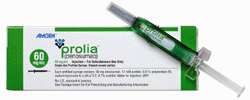Sales of Amgen’s Prolia are set to rise after a “soft” quarter, thanks to a sales force overhaul and an impending return to TV advertising, the company said in a third quarter results call.
The brand, which brought in $110 million for the quarter, went dark on its Blythe Danner consumer ad campaign, said EVP, global commercial operations Tony Hooper, because his team anticipated summer sales doldrums for the osteoporosis drug.
“Quarter 3 tends to be a bit light, and because off that we were not on television,” said Hooper, adding that the past five weeks have seen a spike in sales. “We also took the opportunity to right-size the Prolia sales organization. We ran through the entire target list, we made shire we understand who the prescribers were, we reset the footprint and we actually increased the size of the sales force by about 160 people, which resulted in us being able to call on about a 50% increase in target audience. So if you hear confidence in my voice about the fourth quarter, it’s because I’m coming back strong with DTC, a revised, optimized sales organization, and the first four weeks of data I’ve seen point to positive growth.”
Sales of the injectable monoclonal antibody sank 8% over the same period last year, due in part to unfavorable changes in wholesaler inventories. Prolia is typically given every six months for treatment of osteoporosis. The molecule, denosumab, is also marketed for treatment of cancer-related as Xgeva, which saw a 12% increase in sales for the quarter. Reimbursement issues may put some physicians off in the short term, said Hooper, but will ease over the next year.
Amgen’s top-selling Neulasta/Neupogen franchise was flat, at $1.3 billion, as the company focused on direct-to-patient and caregiver communications aimed at raising awareness of the risk of febrile neutropenia. “We feel it’s important for patients to engage providers in conversations about risk,” said Hooper. The company’s Number Two drug, Enbrel, posted a 17% gain, driven by price increases, to pull in $1 billion for the quarter after a sales force shake-up ahead of the end of Amgen’s profit-share agreement with Pfizer on the brand.
“Last quarter, we discussed three key elements in our near-term strategy,” said Hooper. “First, optimizing the sales force, including the consolidation of all US field sales under Amgen. Secondly, expanding our DTC advertising, and thirdly, ensuring appropriate access. We’ve completed our sales force optimization and made good progress on the other fronts as well.”
Epogen sales increased 3%, driven by reductions in customer discounts and a change in accounting estimates, but suffered from a reduction in dose utilization. Aranesp sales fell 17%, due mainly to changes in practice patterns and a favorable change in accounting estimates, though unit demand was down 3% due to share loss in the US oncology segment.








